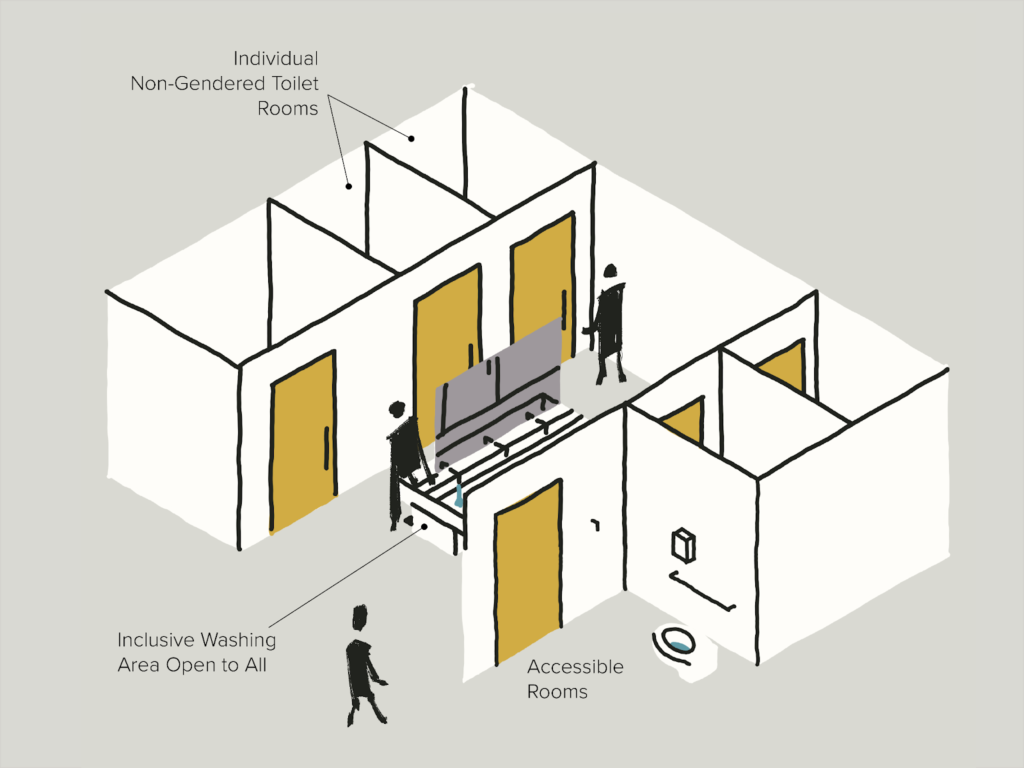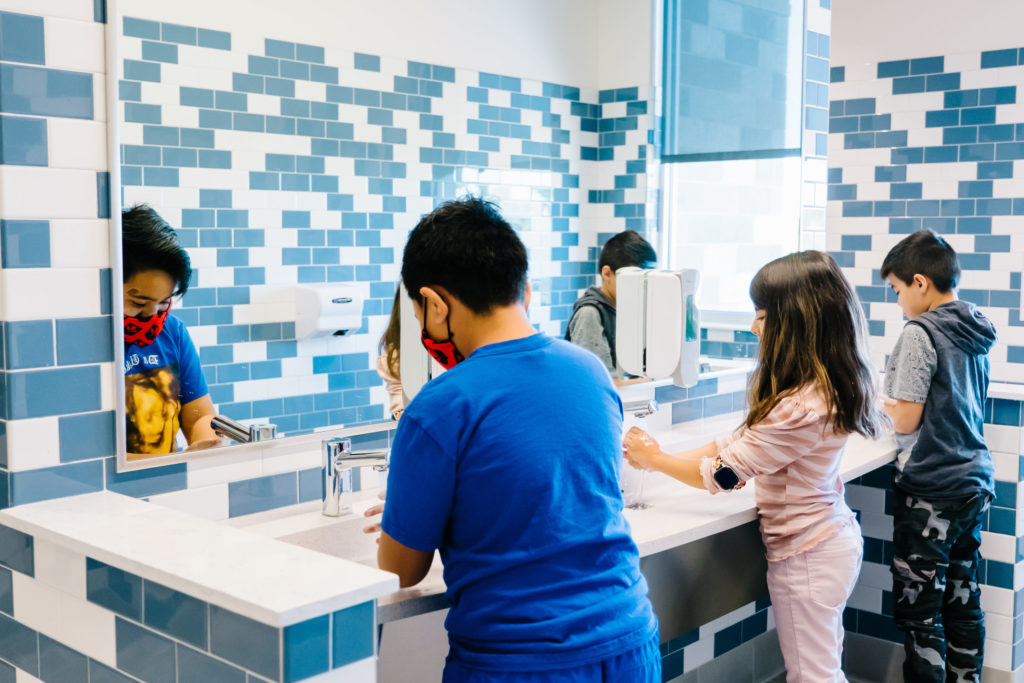Inclusive and Homelike Bathrooms
Key Points
-
Standard toilet room stalls–open at the top and bottom–lack privacy, and are a major cause of anxiety.
-
Separate gender toilet rooms support conventional, binary thinking around gender identity, but fail to create a supportive environment for LGBTQ persons.
-
Individual, non-gendered toilet rooms and inclusive washing areas, open to all, alleviate anxiety around privacy, while also creating an environment where all come together as equals.

By: Randy Fielding & Cierra Mantz
Imagine a typical day in the life of a student. What issues come to mind most connected to student anxiety? You may have thought about: bullying, tests, homework, relationship conflicts, food insecurities, physical appearance, and on-and-on. One thing you may not have thought of…going to the bathroom. However, if stressors were ranked according to students’ day-to-day lived experiences, it would be toward the top of the list.
Most schools have ‘gang style’ restrooms in which multiple toilets and/or urinals are enclosed using partial-height stall partitions that only provide a modicum of visual privacy and no acoustical separation. With this as the setting, now imagine all of the anxiety-inducing experiences one might have: digestive issues, embarrassing noises, no privacy for getting out big emotions or crying, using menstrual products that crinkle and are noisy when you open them, student-on-student abuse behind the closed doors of a ‘student-only’ space. Layer on top of this the experiences of students whose gender identity doesn’t fit neatly into the gender binary that this bathroom design presupposes and the situation is exacerbated ten-fold. At that point, anxiety about using the restroom can become unbearable.
As school designers, this is one of the most consistent problems we see. In fact, during a recent discovery visit to an elementary school in Rhode Island, we asked students to draw their dream school and, astonishingly, nearly 40% of the 4th and 5th-grade students’ drawings included bathrooms. Even more disheartening, two students used their whole drawing as an opportunity to redesign the bathrooms. If students feel the need to devote this much attention to addressing the design of their school’s bathrooms, it’s clearly a major problem. Unprompted, both parents and teachers also brought up the fact that the current restroom facilities were a major point of concern, noting that students need bathrooms that provide a sense of safety, where they could be ensured privacy and a place to let out their emotions and self-regulate.
Restrooms can be organized and arranged to inclusively accommodate the full spectrum of gender expressions, physical abilities, and privacy needs.
Randy Fielding and Cierra Mantz
So, what’s the solution? In an effort to make every person in a school feel safe & welcome, restrooms can be organized and arranged to inclusively accommodate the full spectrum of gender expressions, physical abilities, and privacy needs. By creating fully enclosed toilet rooms with floor-to-ceiling walls, each toilet room has authentic privacy, making it unnecessary to segregate students at all. Each toilet room is non-gendered and open to all. Some toilet rooms are larger to accommodate students with differing physical needs, and a communal sink is open and fully accessible at all times. By opening up the sink area, adults can passively supervise this space to further ensure student safety. More importantly, deemphasizing a gender binary, can instill person-first values that highlight our underline humanity before applying any culturally ascribed identity markers. In this model, instead of bathrooms becoming contentions spaces that divide us, they can become spaces that give us the necessary individual privacy that we all crave, while at the same time, bringing us together around a proverbial watering hole.

Yet, there’s no single model for achieving inclusive bathrooms. Another design solution is what we like to call, ‘home-like’ bathrooms. In this model, each toilet room also contains a sink and mirror so the entire bathroom experience more closely resembles the conditions you might experience at home. This provides an added layer of privacy that may make the bathroom experience even more inclusive. For example, students of various faith backgrounds may want to perform their ablutions behind closed doors so as not to draw attention to themselves. Similarly, for girls and women whose religious beliefs encourage wearing veils or headscarves, it’s important to have a private place with a mirror to occasionally take it off and adjust it during the day. Students who are accustomed to using bidets may need direct access to water to fill hand-held cleansing devices–not something your average student wants to fill up in a communal sink before going into the toilet. And, what about the use of menstrual cups and colostomy bags that need to be emptied and rinsed periodically? For schools that identify the above as issues to address, it may be important to incorporate some home-like bathrooms into each learning community.
School is meant to be a place for learning. However, if students feel unsafe and unwelcome then their basic human needs are not being met, making it impossible for high-level thinking to occur. Being preoccupied with whether you’re going to be bullied in the bathroom, chastised for crying, or embarrassed by your next bowel movement are not concerns students need to have. A simple design solution makes these concerns obsolete. By designing inclusive and homelike bathrooms, we can eliminate one of the many items on students’ list of anxieties. Addressing the others?
At schoolpatterns.com you’ll find many patterns that address school-related anxiety, notably: Learning Community, Choice in Environment, Calming Retreat, Sensory Control, and more!







0 Comments
Leave a Comment
Your email address will not be published. All fields are required.